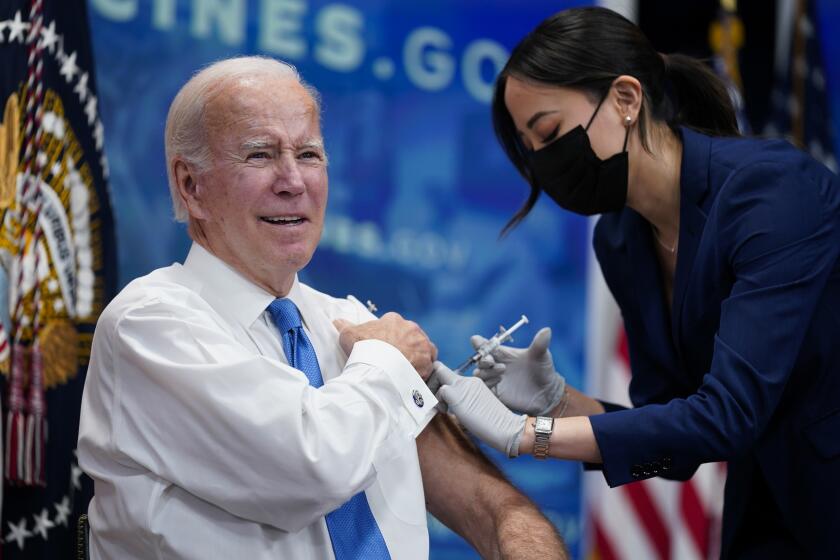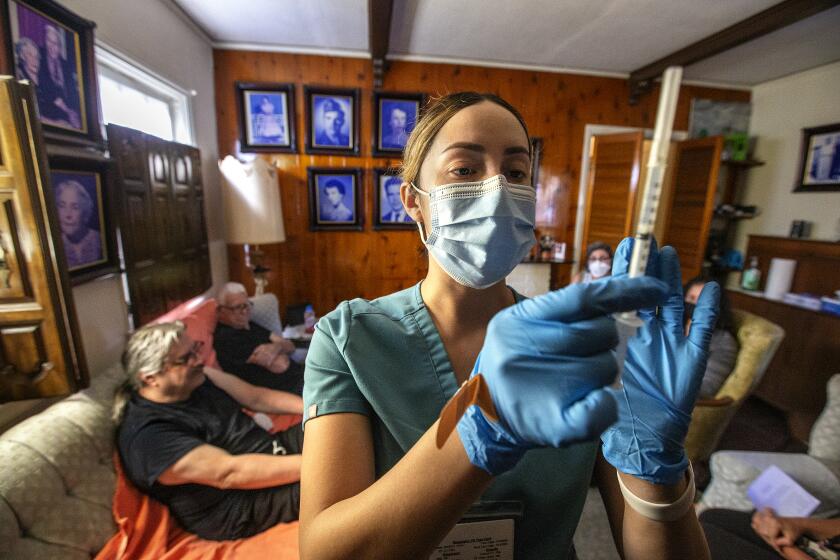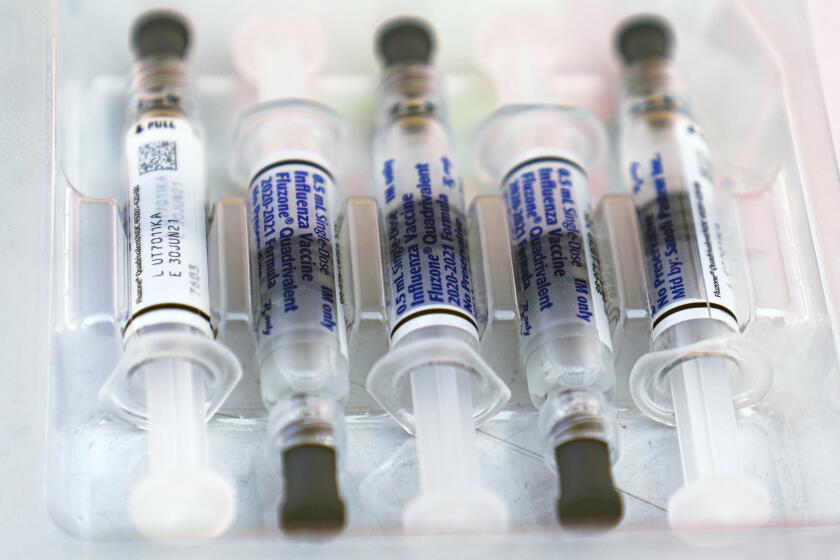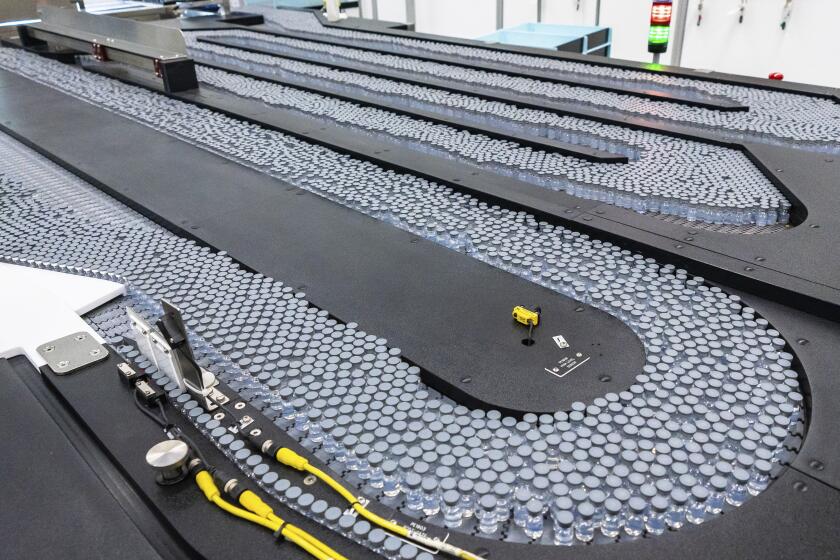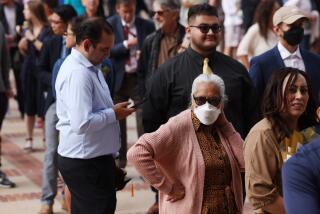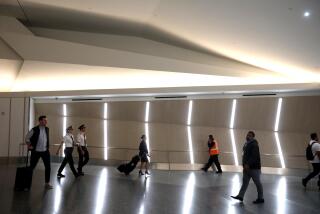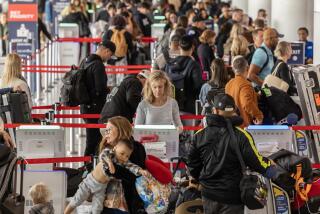New Omicron subvariants BQ.1 and BQ.1.1 make gains as BA.5 fades

- Share via
The rise of new coronavirus subvariants is continuing to erode the grip the Omicron strain BA.5 has held for months, worrying health officials that a winter resurgence of COVID-19 may be ahead.
Eating into BA.5’s long-running dominance are a pair of its own descendants: BQ.1 and BQ.1.1. Like BA.5, the two are subvariants of the original Omicron coronavirus strain that walloped the world last fall and winter.
According to data from the U.S. Centers for Disease Control and Prevention, BA.5 has long accounted for the vast majority of new coronavirus cases nationwide. That these two other strains are increasing in their respective share of cases, however, could indicate they enjoy an additional growth advantage.
But what that ultimately means for this fall and winter — a period when many health experts have already predicted some degree of COVID-19 resurgence — remains to be seen.
Los Angeles County Public Health Director Barbara Ferrer noted recently that “emerging variants and subvariants of the virus have played a large role in driving past surges.”
“We ought to prepare for the possibility of another winter surge. We want to be realistic because every COVID surge brings additional risk,” she said Thursday. “However, we’re also optimistic because we have powerful tools, including therapeutics and the new bivalent boosters, that can blunt the impact.”
President Biden gets his updated COVID-19 booster shot and urges millions of people who have yet to be boosted to do so by Halloween.
At this point, BA.5 remains the most common version of the coronavirus in circulation in the U.S. — making up an estimated 49.6% of new cases over the weeklong period ending Saturday, CDC data show.
As recently as a month ago, federal health officials estimated it was the culprit behind nearly 82% of new cases.
During that same time, BQ.1 has increased its estimated share from 1.2% to 14%, CDC data show. BQ.1.1 has swelled from an estimated 0.5% to 13.1%.
“While there are no data on severity or immune escape from studies in humans, BQ.1 [and its sublineages are] showing a significant growth advantage over other circulating Omicron sublineages in many settings, including Europe and the U.S., and therefore warrant close monitoring,” according to a statement Thursday from the World Health Organization’s Technical Advisory Group on SARS-CoV-2 Virus Evolution.
“It is likely,” the statement continued, “that these additional mutations have conferred an immune escape advantage over other circulating Omicron sublineages, and therefore a higher reinfection risk is a possibility that needs further investigation.”
California is closely watching a rise in new subvariants, as L.A. County and San Francisco Bay Area officials warn that cases are no longer substantially decreasing.
There are no epidemiological data currently suggesting that BQ.1 or its descendants are associated with increased disease severity or that they will significantly diminish vaccine protection against serious illness, according to the statement.
Even if BQ.1 or BQ.1.1 don’t make people sicker, that’s not to say their rise is riskless. As has been seen throughout the pandemic, higher numbers of infections threaten to put additional stress on the healthcare system.
Coronavirus-positive patients, whether admitted for COVID-19 illness or with an incidental infection, require particular attention and resources to keep them from spreading the virus to others. Greater community transmission also can sicken healthcare workers, causing staffing interruptions and even shortages.
The circulation of other respiratory illnesses — namely influenza and respiratory syncytial (sin-SISH-uhl) virus, or RSV — also could compound any challenges presented by a coronavirus rebound. Both RSV and the flu are much more active now than typical for this time of year, a development some worry could foreshadow particularly severe seasons.
After a pandemic-induced lull, influenza is being detected at increased levels for this time of year in Southern California.
“We know that winter is a time when viruses like COVID spread more easily,” Dr. Ashish Jha, the White House COVID-19 response coordinator, said last week. “We’re also seeing a rise of other seasonal viruses like flu and RSV. And we know that COVID is still evolving. We’re seeing new subvariants. We’re seeing an increase in cases and hospitalizations in Europe.”
But while “there are some challenges ahead,” Jha said, “the great news here is that, unlike past winters, we are in control.”
“We have the tools we need to ensure folks have a safe and healthy holiday season,” he said. “And the single most important tool is the updated COVID-19 vaccine.”
Because vaccine protection wanes over time, many could be at higher risk, depending on how long it’s been since they were last inoculated.
As of mid-October, the California Department of Public Health said about 21.9 million people — roughly 78% of all vaccinated recipients — were at least six months removed from their last dose.
The updated bivalent COVID-19 booster shots are available at more than 1,500 sites in Los Angeles County. Here’s how to get one.
Uptake of the updated bivalent boosters, designed to protect not only against the original coronavirus strain but also the Omicron subvariants BA.5 and BA.4, also has been slow.
About 11.4% of eligible Californians have gotten the additional dose, state data show. Nationwide, bivalent coverage among eligible recipients is 7.3%, according to the CDC.
Included in that percentage is President Biden, who received his shot on camera last week to promote the updated vaccine.
“It’s incredibly effective, but the truth is not enough people are getting it,” he said. “We’ve got to change that so we can all have a safe and healthy holiday season.”
In terms of booster coverage, “we’re nowhere near where we need to be to actually enter into the colder months, the holidays, with that sort of additional layer of community protection,” Ferrer said.
“We’re so lucky to live in this country where we have ample access to one of the best protections against serious consequences of either influenza or COVID, which are making sure that we’re getting our vaccine,” she said Thursday. “So we’d like to make sure everyone understands we’re not helpless here. And we’re particularly not helpless on trying to really dampen the impact that a lot of transmission can have on our healthcare system.”
“Getting both vaccines at the same visit increases the chance that a person will be up to date with their vaccinations,” the CDC says.
In L.A. County, coronavirus cases are no longer declining at the rate seen over the summer and appear to have plateaued. For the seven-day period that ended Monday, L.A. County was averaging 979 cases a day, a 7% increase from the prior week. On a per capita basis, L.A. County was recording about 68 cases a week for every 100,000 residents.
“We’re no longer seeing a steady decline in cases,” Ferrer said. L.A. County’s case rate began showing week-over-week increases just after mid-October.
Statewide, cases also may be starting to increase. The daily average number of cases in California rose by 18% for the most recent week of data available, from 2,681 to 3,152. On a per capita basis, the state was recording 56 cases a week for every 100,000 residents.
Viral levels in wastewater — a key metric as many coronavirus cases are being self-diagnosed using at-home tests and aren’t officially reported to public health departments — also are increasing in L.A. County. The level is now 31% of the summer peak recorded in July, up from 21% a week earlier.
Ferrer characterized the increase as “slight” and “not cause for alarm.” Nonetheless, it suggests “locally there is no longer a consistent decline in COVID-19 transmission.”
Reports from thousands of people who’ve had COVID-19 suggest that the most common symptoms vary according to their vaccination status.
L.A. County’s death rate has remained largely stable for the last month, averaging 65 to 84 COVID-19 deaths per week. That’s an improvement from the summer Omicron peak of 122 deaths a week but still well above the springtime lull in May, when weekly deaths fell to a low of 24 COVID-19 deaths a week.
The U.S. averaged roughly 400 COVID-19 deaths a day in October, higher than the springtime lull of about 300 daily deaths.
“We still have hundreds of people dying each day from COVID in this country — hundreds. That number is likely to rise this winter,” Biden said. “But this year is different from the past. This year, nearly every death is preventable.”
For the yearlong period that ended Oct. 26, the deaths of roughly 315,000 U.S. residents from COVID-19 have been reported. That’s nine times the average national number of flu deaths a year, which is about 35,000.
Ferrer noted BQ.1 and BQ.1.1 have attracted considerable attention “because nationally, they observed a doubling in a very short period of time, and we need to pay attention to that.”
Thus far, however, they remain at low levels in L.A. County. For the week that ended Oct. 8, both accounted for only 2.7% of weekly specimens in L.A. County.
“With the relatively low numbers of recently sequenced specimens of these new sublineages in L.A. County, there’s no one candidate that we can say with certainty that is likely to outcompete other circulating strains,” Ferrer said. But it’s important to monitor trends elsewhere to see what could come next, she added.
More to Read
Sign up for Essential California
The most important California stories and recommendations in your inbox every morning.
You may occasionally receive promotional content from the Los Angeles Times.
